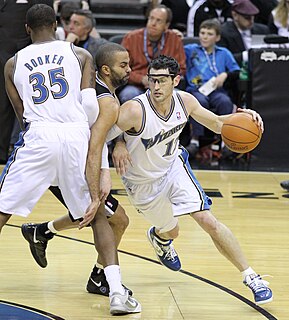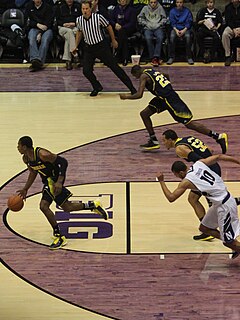Related Research Articles

Basketball is a team sport in which two teams, most commonly of five players each, opposing one another on a rectangular court, compete with the primary objective of shooting a basketball through the defender's hoop (a basket 18 inches in diameter mounted 10 feet high to a backboard at each end of the court, while preventing the opposing team from shooting through their own hoop. A field goal is worth two points, unless made from behind the three-point line, when it is worth three. After a foul, timed play stops and the player fouled or designated to shoot a technical foul is given one, two or three one-point free throws. The team with the most points at the end of the game wins, but if regulation play expires with the score tied, an additional period of play is mandated.

In basketball, free throws or foul shots are unopposed attempts to score points by shooting from behind the free-throw line, a line situated at the end of the restricted area. Free throws are generally awarded after a foul on the shooter by the opposing team, analogous to penalty shots in other team sports. Free throws are also awarded in other situations, including technical fouls, and when the fouling team has entered the bonus/penalty situation. Also, depending on the situation, a player may be awarded between one and three free throws. Each successful free throw is worth one point.

In basketball, a personal foul is a breach of the rules that concerns illegal personal contact with an opponent. It is the most common type of foul in basketball. A player fouls out on reaching a limit on personal fouls for the game and is disqualified from participation in the remainder of the game.

The rules of basketball are the rules and regulations that govern the play, officiating, equipment and procedures of basketball. While many of the basic rules are uniform throughout the world, variations do exist. Most leagues or governing bodies in North America, the most important of which are the National Basketball Association and NCAA, formulate their own rules. In addition, the Technical Commission of the International Basketball Federation (FIBA) determines rules for international play; most leagues outside North America use the complete FIBA ruleset.

The pick and roll in basketball is an offensive play in which a player sets a screen (pick) for a teammate handling the ball and then moves toward the basket (rolls) to receive a pass. In the NBA, the play came into vogue in the 1990s and has developed into the league's most common offensive action. There are, however, many ways in which the defense can also counter the offensive screen.

In the sport of basketball, five players play per team, each assigned to positions. Historically, these players have been assigned, to positions defined by the role they play on the court, from a strategic point of view. The three main positions are guard, forward, and center, with the standard team featuring two guards, two forwards, and a center. Over time, as more specialized roles developed, each of the guards and forwards came to be differentiated, and today each of the five positions are known by unique names, each of which has also been assigned a number: point guard (PG) or 1, the shooting guard (SG) or 2, the small forward (SF) or 3, the power forward (PF) or 4, and the center (C) or 5.
Zone defense is a type of defense, used in team sports, which is the alternative to man-to-man defense; instead of each player guarding a corresponding player on the other team, each defensive player is given an area to cover.
Man-to-man defense, or man defense, is a type of defensive technique used in team sports such as American football, association football, basketball, and netball, in which each player is assigned to defend and follow the movements of a single player on offense. Often, a player guards his counterpart, but a player may be assigned to guard a different position. However, the strategy is not rigid, and a player might switch assignment if needed, or leave his own assignment for a moment to double team an offensive player. The term is commonly used in both men's and women's sports. The alternative to man-to-man defense is zone defense, a system of defense in which each player guards an assigned area rather than a specified opponent.
Basketball moves are generally individual actions used by players in basketball to pass by defenders to gain access to the basket or to get a clean pass to a teammate to score.

Fast break is an offensive strategy in basketball and handball. In a fast break, a team attempts to move the ball up court and into scoring position as quickly as possible, so that the defense is outnumbered and does not have time to set up. The various styles of the fast break–derivative of the original created by Frank Keaney–are seen as the best method of providing action and quick scores. A fast break may result from cherry picking.

'Rebound' is a term used in sports to describe the ball becoming available for possession by either opponent after an attempt to put the ball or puck into the goal has been unsuccessful. Rebounds are generally considered to be a major part of the game, as they often lead either to a possession change or to a second opportunity to score by the side whose initial attempt failed.

In basketball, a rebound, sometimes colloquially referred to as a board, is a statistic awarded to a player who retrieves the ball after a missed field goal or free throw.

This glossary of basketball terms is a list of definitions of terms used in the game of basketball. Like any other major sport, basketball features its own extensive vocabulary of unique words and phrases used by players, coaches, sports journalists, commentators, and fans.

In basketball, a double team is a defensive alignment in which two defensive players are assigned to guard a single offensive player.
Variations of basketball are games or activities based on, or similar in origin to, the game of basketball, in which the player utilizes common basketball skills. Some are essentially identical to basketball, with only minor rules changes, while others are more distant and arguably not simple variations but distinct games. Other variations include children's games, contests or activities intended to help the player practice or reinforce skills, which may or may not have a competitive aspect. Most of the variations are played in informal settings, without the presence of referees or other officials and sometimes without strict adherence to official game rules.
The following terms are used in water polo. Rules below reflect the latest FINA Water Polo Rules.
In basketball, the five-second rule, or five-second violation, is a rule that helps promote continuous play. There are multiple situations where a five-second violation may occur.

Offside, often pluralized as Offsides in American English, is a rule used by several different team sports regulating aspects of player positioning. It is particularly used in field sports with rules deriving from the various codes of football, such as association football, rugby union and rugby league, and in similar 'stick and ball' sports e.g. ice hockey, broomball, field hockey and bandy.

The 1–3–1 defense and offense is a popular strategy used in basketball.
Basketball is a ball game and team sport in which two teams of five players try to score points by throwing or "shooting" a ball through the top of a basketball hoop while following a set of rules. Since being developed by James Naismith as a non-contact game that almost anyone can play, basketball has undergone many different rule variations, eventually evolving into the NBA-style game known today. Basketball is one of the most popular and widely viewed sports in the world.
References
- 1 2 "Basketball Dictionary". Wireless Communications Research Group, Stanford University. Archived from the original on 2012-04-23.
- ↑ "Cherry Picking as NBA Strategy". ESPN. 2007-04-12.
- ↑ "Basketball Terms - Basketball Definitions - Basketball Terminology". Basketball.lifetips.com. Retrieved 2012-10-11.
- ↑ "How to coach and teach the basketball 2-1-2 half-court zone defense". Guidetocoachingbasketball.com. Retrieved 2012-10-11.
- ↑ "The real understanding of "Cherry-picking"". hoopsgaming.com. 2012-11-16.
